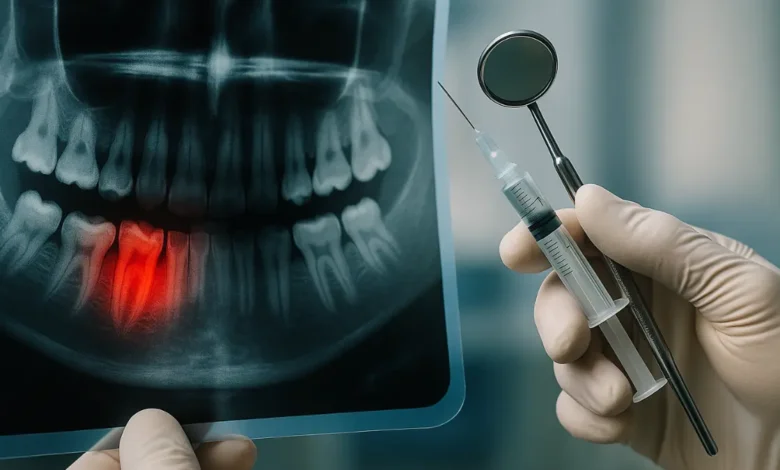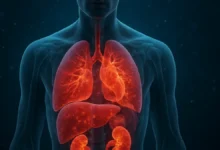How Long Until a Tooth Infection Kills You: The Hidden Danger Behind a Simple Toothache

Discover how long until a tooth infection kills you, the real dangers of untreated dental abscesses, warning signs, stages, and expert advice on prevention, treatment, and survival.
A toothache can be annoying, sharp, or throbbing — but when it lingers for days or worsens with time, it may not be just a cavity. Deep inside your jaw, an infection could be brewing. Many people have heard horror stories of untreated dental infections leading to serious illness or even death, prompting one terrifying question: how long until a tooth infection kills you?
The short answer is that while modern medicine makes such deaths rare, a tooth infection can still be fatal if ignored long enough. Depending on the severity, a person could go from mild discomfort to a life-threatening situation in a matter of weeks — or in extreme cases, just a few days.
This guide breaks down everything you need to know — from what actually happens inside an infected tooth, to how it spreads, how long it takes to become dangerous, and how to protect yourself before it’s too late.
Understanding What a Tooth Infection Really Is
At its core, a tooth infection — also called a dental abscess — is a bacterial invasion of the pulp inside your tooth. The pulp contains nerves, blood vessels, and soft tissue that keep the tooth alive. Once bacteria reach this area, they multiply, creating inflammation, pressure, and pus.
The infection usually begins with a small cavity or crack in the enamel that allows bacteria to slip inside. It might seem harmless at first, but the infection won’t stop there. It can move deeper into the root, into the jawbone, and eventually into surrounding tissues.
There are three main types of abscesses that can form:
- Periapical abscess: develops at the tip of the root, usually from untreated decay.
- Periodontal abscess: starts in the gums next to a tooth root.
- Gingival abscess: limited to the gum surface but still painful and dangerous if ignored.
When left untreated, an abscess behaves like a pressure cooker — the infection builds up until it finds somewhere to escape, whether that’s through bone, soft tissue, or into the bloodstream.
The Early Warning Signs You Should Never Ignore
Most people don’t realize how quickly an untreated tooth infection can progress. It often starts small — a mild toothache, tenderness when chewing, or sensitivity to temperature. However, as bacteria grow and the infection deepens, the symptoms become harder to dismiss.
Common signs of a developing infection include:
- Persistent throbbing pain
- Swelling in the face, cheek, or jaw
- Red, inflamed gums
- A bad taste or foul odor from the mouth
- Fever or general fatigue
- Pain radiating to the ear, neck, or head
When pain suddenly disappears after days of suffering, many think the infection is gone. In reality, this can mean the nerve inside the tooth has died — and the bacteria are now moving deeper without resistance.
Ignoring these signals is what allows a simple dental problem to turn into a potentially deadly condition.
The Stages of a Tooth Infection and How It Escalates
To understand how long until a tooth infection kills you, it helps to look at how it progresses over time. Though the timeline varies from person to person, the pattern is surprisingly consistent.
| Stage | Duration | What Happens | Risk Level |
|---|---|---|---|
| Early infection | A few days to weeks | Bacteria enter the pulp; pain and swelling begin | Low |
| Abscess formation | Weeks to months | Pus pocket forms under pressure | Moderate |
| Local spread | Weeks to months | Infection spreads to gums, jaw, and soft tissues | High |
| Systemic spread | Days to weeks | Bacteria enter bloodstream or deep tissue spaces | Critical |
| Sepsis or organ failure | Hours to days | Widespread infection overwhelms body | Life-threatening |
At first, the infection is local — painful but manageable with proper dental treatment. But once bacteria breach the tooth and enter the bloodstream, things become unpredictable and fast-moving.
If the infection spreads to vital areas like the neck, brain, or chest, it can quickly turn fatal without medical intervention.
How Long Until a Tooth Infection Becomes Dangerous
The honest truth? It varies — but it can be faster than you’d think. For most healthy adults, a localized tooth infection can take weeks or months to become life-threatening. But once the infection begins to spread, deterioration can happen within days.
In people with weakened immune systems — such as those with diabetes, cancer, HIV, or chronic illness — the progression can be even quicker. In rare cases, individuals have died within a few days of an abscess rupturing or spreading.
Once systemic infection or sepsis begins, every hour counts. Sepsis can lead to multi-organ failure, septic shock, and death if not treated immediately. The body essentially turns on itself in an overreaction to infection.
That’s why the only safe answer to “how long until a tooth infection kills you” is this: never wait to find out.
How a Tooth Infection Kills: The Medical Explanation
When bacteria from the tooth’s abscess spread beyond the root and into surrounding tissue, they find pathways to critical areas. Blood vessels, lymph nodes, and facial spaces provide corridors straight to the brain, lungs, or heart.
Here’s what can happen inside the body:
- Sepsis: the body’s immune system overreacts to infection, causing widespread inflammation and tissue damage.
- Brain abscess: bacteria migrate upward from the upper jaw, forming infected pockets in the brain.
- Endocarditis: bacteria attach to heart valves, causing dangerous inflammation.
- Ludwig’s angina: infection spreads into the neck, closing the airway and suffocating the patient.
- Osteomyelitis: infection reaches the jawbone, eating away at bone tissue.
Each of these conditions can turn deadly without fast medical treatment. What started as a toothache can become a full-blown emergency.
Who Is at the Highest Risk
Some people can fight off infection longer, while others decline faster. Several risk factors make a person more vulnerable to rapid spread and death from a dental abscess.
- Weak immune system: from diseases or medications.
- Poor dental hygiene: long-term neglect allows bacteria to flourish.
- Chronic illness: diabetes, cancer, or heart disease can reduce healing ability.
- Elderly age: slower immune response makes infections harder to contain.
- Substance abuse: alcohol and tobacco weaken the body’s defenses.
- Malnutrition or dehydration: lowers resilience.
Even young, healthy individuals can die from a severe tooth infection if it spreads undetected. In fact, several documented cases involved people who delayed treatment for financial or scheduling reasons, assuming it would “heal on its own.”
Common Myths About Tooth Infections
“If the pain goes away, I’m fine.”
False. Pain relief may mean the nerve has died, not that the infection is gone.
“I can just use antibiotics at home.”
Wrong. Antibiotics can help temporarily, but they can’t drain pus or remove dead tissue. Without dental treatment, the infection often returns stronger.
“It’s just a tooth — it can’t kill me.”
Sadly, history says otherwise. Even with today’s medicine, untreated infections still claim lives every year.
“I’ll just take painkillers until it heals.”
Painkillers mask symptoms but do nothing to cure infection. You might feel better while bacteria spread quietly deeper into your bloodstream.
When to Go to the Dentist or Emergency Room
You should never wait to see how bad it gets. However, certain signs mean the infection may have already started spreading:
- Swelling that extends to your cheek, eye, or neck
- Fever or chills
- Trouble swallowing or breathing
- Severe throbbing or pressure that won’t subside
- Nausea, vomiting, or dizziness
- Fatigue and confusion
If you notice any of these, head to the emergency room immediately. Don’t try to “tough it out.” Once the infection becomes systemic, hours can make the difference between recovery and catastrophe.
Treatment That Can Stop a Tooth Infection from Killing You
The good news: tooth infections are entirely curable with timely care. The right dental and medical treatment can stop bacteria before they become deadly.
Drainage of the Abscess
The dentist will create a small incision to release the trapped pus, relieving pressure and pain. This is often the first and fastest step toward recovery.
Root Canal Therapy
If the tooth is salvageable, the infected pulp is removed, the root cleaned, and the space sealed. This eliminates the source of bacteria while saving the natural tooth.
Tooth Extraction
If the damage is too severe, removing the tooth may be necessary to prevent further spread. Extraction is quick and eliminates the bacterial hub completely.
Antibiotics
While antibiotics alone can’t cure an abscess, they’re crucial to control and prevent spread after surgical or dental treatment.
Hospitalization
In severe cases — where swelling affects breathing, or sepsis is suspected — intravenous antibiotics, fluids, and close monitoring are required in a hospital setting.
With early intervention, even serious infections can be fully cured without lasting harm.
Prevention Is Easier Than a Cure
Avoiding this nightmare scenario is simpler than most realize. A few consistent habits can make “how long until a tooth infection kills you” a question that never needs asking.
- Brush and floss twice daily.
- Limit sugary and acidic foods.
- Drink plenty of water.
- Get regular dental checkups and cleanings.
- Address tooth pain early instead of waiting.
- Avoid smoking and heavy alcohol use.
A healthy mouth is the first line of defense against systemic infection. The longer you wait to treat a dental problem, the higher the stakes become.
Real-Life Perspective: Why This Still Happens
It’s easy to assume that no one dies from tooth infections anymore — but modern healthcare doesn’t guarantee prevention. People delay care because of cost, fear, or underestimating the danger.
Emergency departments around the world still report cases of sepsis and deep neck infections caused by untreated teeth. Many survivors describe the experience as starting with what felt like a “simple toothache” that quickly spiraled into hospitalization.
This is why dental professionals constantly emphasize: pain is not normal. A toothache is your body’s alarm system — not a minor inconvenience to ignore.
Expert Quote
“The mouth is connected to every system in the body. An untreated dental infection doesn’t stay in one place — it travels. What starts in the tooth can end in the bloodstream, the brain, or the heart.”
— Dr. Lauren Fields, DDS
Summary Table of Risks and Recommended Actions
| Infection Stage | Warning Signs | What’s Happening | What You Should Do |
|---|---|---|---|
| Early tooth infection | Mild pain, sensitivity | Bacteria entering pulp | Schedule a dental visit immediately |
| Abscess forming | Swelling, pus, throbbing pain | Pressure and tissue damage | Get drainage and antibiotics |
| Spreading infection | Face or jaw swelling, fever | Infection leaving tooth | Seek urgent dental or medical care |
| Systemic infection | Confusion, breathing trouble | Bacteria in bloodstream | Go to the emergency room immediately |
Frequently Asked Questions
What happens if you ignore a tooth infection?
Ignoring it allows bacteria to multiply and spread beyond the tooth. Eventually, it can reach the jawbone, bloodstream, or brain, leading to sepsis or death.
Can you die from a tooth infection?
Yes, it’s rare but possible. Once bacteria spread beyond the mouth, the infection can affect vital organs and become fatal within days if untreated.
How fast can a tooth infection kill you?
While it may take weeks for symptoms to worsen, once the infection becomes systemic, it can turn deadly in just a few days.
Will antibiotics alone fix a tooth infection?
No. Antibiotics can control spread temporarily but cannot remove the source. You’ll still need dental treatment like a root canal or extraction.
How do I know if my tooth infection is serious?
Severe pain, swelling, fever, fatigue, or difficulty breathing are all signs that the infection may be spreading. Seek emergency care immediately.
Can a tooth infection cause sepsis?
Absolutely. When bacteria from the infection enter the bloodstream, the body’s inflammatory response can trigger sepsis — a life-threatening emergency.
Is it safe to wait for dental treatment?
Delaying care is risky. Even small infections can spread quickly. Always treat dental pain as an urgent medical concern.
Conclusion
So, how long until a tooth infection kills you? The truth is that it depends — but once a dental abscess escapes the tooth, time becomes your enemy. In healthy individuals, it might take weeks or months to become critical. In others, just days.
No one should ever die from a treatable tooth infection. The real danger lies in delay, neglect, and underestimation. A quick visit to the dentist can save you from a lifetime of regret — or, in the worst cases, save your life entirely.





